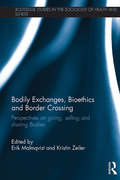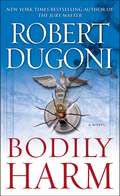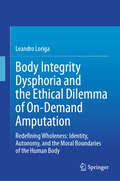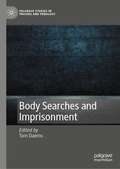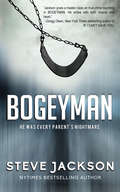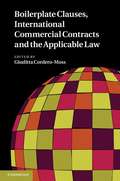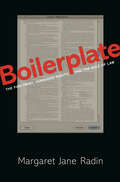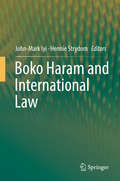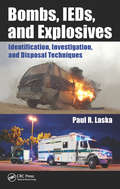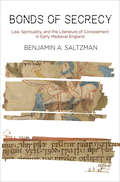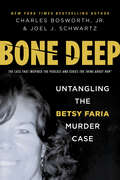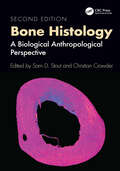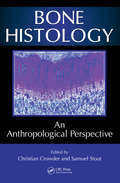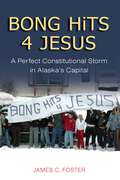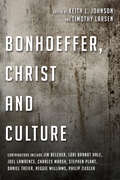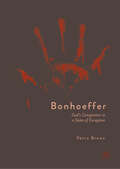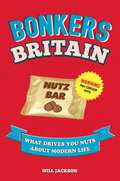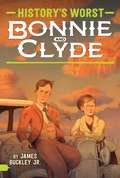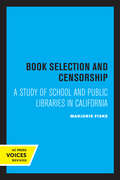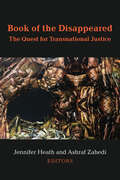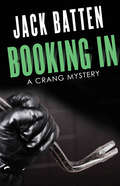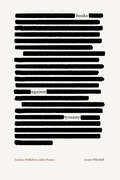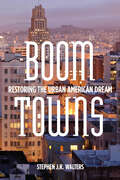- Table View
- List View
Bodily Exchanges, Bioethics and Border Crossing: Perspectives on Giving, Selling and Sharing Bodies
by Erik Malmqvist Kristin ZeilerMedical therapy, research and technology enable us to make our bodies, or parts of them, available to others in an increasing number of ways. This is the case in organ, tissue, egg and sperm donation as well as in surrogate motherhood and clinical research. Bringing together leading scholars working on the ethical, social and cultural aspects of such bodily exchanges, this cutting-edge book develops new ways of understanding them. Bodily Exchanges, Bioethics and Border Crossing both probes the established giving and selling frameworks for conceptualising bodily exchanges in medicine, and seeks to develop and examine another, less familiar framework: that of sharing. A framework of sharing can capture practices that involve giving up and giving away part of one’s body, such as organ and tissue donation, and practices that do not, such as surrogacy and research participation. Sharing also recognizes the multiple relationalities that these exchanges can involve and invites inquiry into the context in which they occur. In addition, the book explores the multiple forms of border crossing that bodily exchanges in medicine involve, from the physical boundaries of the body to relational borders – as can happen in surrogacy – to national borders and the range of ethical issues that these various border-crossings can give rise to. Engaging with anthropology, sociology, philosophy, and feminist and postcolonical perspectives, this is an original and timely contribution to contemporary bioethics in a time of increasing globalization. It will be of use to students and researchers from a range of humanities and social science backgrounds as well as medical and other healthcare professionals with an interest in bioethics.
Bodily Harm: A Novel (David Sloane Ser. #3)
by Robert DugoniNew York Times bestselling author Robert Dugoni returns with his most exhilarating legal thriller to date, a pulse-pounding story of corporate greed, espionage, and the lengths one man is willing to go for justice.Bodily Harm opens with a big win for David Sloane and his new partner, Tom Pendergrass, in a malpractice case centered on the death of a young child. But on the heels of this seeming victory, an unlikely character—toy designer Kyle Horgan— comes forward to tell Sloane that he&’s gotten it all wrong: Horgan&’s the one who&’s truly responsible for the little boy&’s death and possibly others—not the pediatrician Sloane has just proven guilty. Ordinarily, Sloane might have dismissed such a person as a crackpot, but something about this case has always troubled him—something that he couldn&’t quite pinpoint. When Sloane tries to follow up with Horgan, he finds the man&’s apartment a shambles— ransacked by unknown perpetrators. Horgan has vanished without a trace. Together with his longtime investigative partner Charles Jenkins, Sloane reexamines his clients&’ son&’s death and digs deeper into Horgan&’s claims, forcing him to enter the billion-dollar, cutthroat toy industry. As Sloane gets closer to the truth, he trips a wire that leads to a shocking chain of events that nearly destroys him. To get to the bottom of it all and find justice for the families harmed, Sloane must keep in check his overwhelming desire for revenge. Full of nail-bitingly tense action scenes as well as edge-of-your-seat courtroom drama, Bodily Harm finds Robert Dugoni at the very top of his game.
Body Integrity Dysphoria and the Ethical Dilemma of On-Demand Amputation: Redefining Wholeness: Identity, Autonomy, and the Moral Boundaries of the Human Body
by Leandro LorigaThis book, explores the complex moral and ethical dilemmas surrounding Body Integrity Dysphoria (BID) and its recent classification in the ICD-11. The examination offers a pioneering view into a condition that remains deeply controversial within medical and public discourse. BID is characterised by a persistent desire to acquire a physical impairment, often through amputation. Such a situation forces the medical world to take a stance by either granting the amputation request or rejecting it with the risk of pushing individuals toward self-made solutions. Through a review of the contemporary understanding of BID as well as original data obtained during extensive fieldwork with medical professionals, this book addresses the ethical and moral aspects of the condition. Fundamental questions are posed about the relationship between bodily autonomy and embodiment, identity and gender, well-being and moral responsibility, and how these elements intertwine, shape and are shaped by sociocultural understanding of illness and body. The book aims to move beyond traditional understandings of body functionality to consider the implications of autonomy and the extent to which an individual considered mentally and physically sound can dispose of one's own body within the contemporary medical paradigm. This is done to question long-standing assumptions about bodily integrity and traditional views on the wholeness and naturalness of the human form. As postmodern theories challenge established frameworks, a paradigm shift emerges in medical and societal approaches to identity, embodiment, and impairment, and this needs to be addressed. Drawing on insights from medicine, psychology, sociology, and ethics, this book situates BID within a broader cultural and philosophical context. It raises essential questions about where individuals' rights intersect with medical responsibility and societal perceptions of normalcy and health. By doing so, the book provokes readers to reconsider the boundaries between health, pathology, and self-determination.
Body Searches and Imprisonment (Palgrave Studies in Prisons and Penology)
by Tom DaemsThis book explores and addresses body search practices in prison environments from different angles (criminology, sociology, human rights and law) and discusses such practices in different national contexts within Europe. Body searches are widely used in prison systems across the globe: they are perceived as indispensable to prevent forbidden substances, weapons or communication devices from entering the prison. However, these are also invasive and potentially degrading control techniques. It should not come as a surprise, then, that body searches are deeply contested security measures and that they have been widely debated and regulated. What makes theses control measures problematic in a prison context? How do these practices come to be regulated in an international and European context? How are rules translated into national law? To what extent are laws and rules respected, bent, circumvented and denied? And what does the future hold for body searches?
Body and Soil
by Ralph McInernyMARRIAGE MADE IN HELL... “The prosecutor is going to suggest you went home, killed Hal, and then went to Sylvia’s.” “But I didn’t! It’s not true.” “And our job is to make sure people see that you didn’t kill him. We’re going to have to do better than saying you were driving around for two hours trying to think. So let’s start there. You’re going to have to remember that drive.” “Andrew, I haven’t been arrested. Nobody has accused me of anything. Does a person have to prove she’s innocent?” “Let’s call it a day then. But I want you to try to reconstruct the time between leaving the club and getting to Sylvia’s. You weren’t drunk, were you?” “I’ve never been drunk a day in my life.” “Do me a favor, Pauline. Don’t say that under oath.”
Bogeyman: He Was Every Parent's Nightmare
by Steve JacksonThe New York Times bestselling author &“gives a master class on true crime reporting in Bogeyman. He writes with both muscle and heart&” (Gregg Olsen, #1 New York Times bestselling author). Bogeyman describes in dramatic detail and with heartrending poignancy the efforts of tenacious Texas lawmen to solve the cold case murders of three little girls and hold serial child killer David Elliot Penton accountable for his horrific crimes. From the book: &“For years he&’d stalked elementary schools and playground looking for young girls from low-income neighborhoods to abduct, rape and murder. He thought of them as &‘throwaway kids&’—hardly missed, and soon forgotten, except by those who loved them. He was every parent&’s worst nightmare. The bogeyman they warned their children about . . . the fiend who lurked outside bedroom windows.&” &“Absorbing and haunting! Bogeyman spills creepily across the page with Steve Jackson&’s hellacious verve and insight, reminding us there are few better explorers of the American berserk.&”—Ron Franscell, bestselling author of Alice & Gerald: A Homicidal Love Story &“Steve Jackson&’s latest, Bogeyman, reveals a living, breathing nightmare that haunted parents, as well as detectives. Be sure to add it to your reading list if you&’re a fan of true crime books.&”—Aaron Habel, host of Generation Why Podcast &“There are true crime books that just lay out the facts, and there are true crime books that pull you deeply into a world. Jackson writes deeply . . . It&’s all in Bogeyman, a fascinating, well-paced read about the lows and highs of cold case investigations.&”—Katherine Ramsland, bestselling author and professor of forensic psychology, in Psychology Today
Boilerplate Clauses, International Commercial Contracts and the Applicable Law
by Giuditta Cordero-MossWith the aim of creating an autonomous regime for the interpretation and application of the contract, boilerplate clauses are often inserted into international commercial contracts without negotiations or regard for their legal effects. The assumption that a sufficiently detailed and clear language will ensure that the legal effects of the contract will only be based on the contract, as opposed to the applicable law, was originally encouraged by English courts, and today most international contracts have these clauses, irrespective of the governing law. This collection of essays demonstrates that this assumption is not fully applicable under systems of civil law, because these systems are based on principles, such as good faith and loyalty, which contradict this approach.
Boilerplate: The Fine Print, Vanishing Rights, and the Rule of Law
by Margaret Jane RadinWhy the increasing use of boilerplate is eroding our rightsBoilerplate—the fine-print terms and conditions that we become subject to when we click "I agree" online, rent an apartment, enter an employment contract, sign up for a cellphone carrier, or buy travel tickets—pervades all aspects of our modern lives. On a daily basis, most of us accept boilerplate provisions without realizing that should a dispute arise about a purchased good or service, the nonnegotiable boilerplate terms can deprive us of our right to jury trial and relieve providers of responsibility for harm. Boilerplate is the first comprehensive treatment of the problems posed by the increasing use of these terms, demonstrating how their use has degraded traditional notions of consent, agreement, and contract, and sacrificed core rights whose loss threatens the democratic order.Margaret Jane Radin examines attempts to justify the use of boilerplate provisions by claiming either that recipients freely consent to them or that economic efficiency demands them, and she finds these justifications wanting. She argues, moreover, that our courts, legislatures, and regulatory agencies have fallen short in their evaluation and oversight of the use of boilerplate clauses. To improve legal evaluation of boilerplate, Radin offers a new analytical framework, one that takes into account the nature of the rights affected, the quality of the recipient's consent, and the extent of the use of these terms. Radin goes on to offer possibilities for new methods of boilerplate evaluation and control, among them the bold suggestion that tort law rather than contract law provides a preferable analysis for some boilerplate schemes. She concludes by discussing positive steps that NGOs, legislators, regulators, courts, and scholars could take to bring about better practices.
Boko Haram and International Law
by John-Mark Iyi Hennie StrydomThis book focuses on Boko Haram and terrorism in Nigeria, framing the conflict in an international law context. It analyses the nature of political violence and the dominant roles of a violent nation-state (in both colonial and post-colonial experiences) and the rise of terrorism in Nigeria. The book unearths embedded evidence of religious nepotism on the part of state officials using such state institutions as Islamic Preaching Boards to promote one Islamic sect over another in mainly Muslim Northern Nigeria. The book offers insights into this subtle sectarian divide and how this and other ‘subterranean’ elements have contributed to the rise of Boko Haram in Northern Nigeria beyond the dominant poverty-terrorism nexus narrative. Furthermore, the book analyses the various components of Boko Haram’s radical ideology, situates them in Islamic Jurisprudence, and examines the philosophy of the group (both in doctrine and practice) – their interpretation of the Koran and the waging of Jihad, and the extent to which they conform to the Islamic Sect Boko Haram claims to follow. The book then examines the basic doctrinal features and characteristics of Boko Haram – waging Jihad, prohibiting revealing dresses for women and mixing of genders, rejecting western values and institutions, denouncing scientific inquiry and democracy, hostage taking, sexual exploitation of captives and other aspects of jus ad bellum and jus in bello in Islamic jurisprudence and international law. Finally, the book analyses the plight of vulnerable groups such as internally displaced persons, the atrocities committed against women and girls in the Boko Haram insurgency and the (in)ability of international law to enforce the protections offered to the victims. From the perspective of critical intellectual inquiry, the book also challenges a number of fundamental assumptions and encourages us to revisit our legal characterisation of certain concepts such as “gender-based crimes”. It then goes further to analyse some legal grey areas in the Boko Haram insurgency such as the legal status of the Civilian Joint Task Force (CJTF) and the legal framework for holding members accountable for violations of international human rights and humanitarian law. Overall, the book represents a valuable contribution to scholarship, deepens our understanding and delineates how international law could respond to the Boko Haram insurgency in Nigeria in particular and terrorism in Africa in general.
Bombs, IEDs, and Explosives: Identification, Investigation, and Disposal Techniques
by Paul R. LaskaA guide on procedures, administration, and equipment, Bombs, IEDs, and Explosives: Identification, Investigation, and Disposal Techniques introduces concepts, basic knowledge, and necessary skill sets for bomb technicians. It covers topics such as training resources, bomb threat and incident response, legal aspects of bomb disposal, explosives and
Bonds of Secrecy: Law, Spirituality, and the Literature of Concealment in Early Medieval England (The Middle Ages Series)
by Benjamin A. SaltzmanWhat did it mean to keep a secret in early medieval England? It was a period during which the experience of secrecy was intensely bound to the belief that God knew all human secrets, yet the secrets of God remained unknowable to human beings. In Bonds of Secrecy, Benjamin A. Saltzman argues that this double-edged conception of secrecy and divinity profoundly affected the way believers acted and thought as subjects under the law, as the devout within monasteries, and as readers before books. One crucial way it did so was by forming an ethical relationship between the self and the world that was fundamentally different from its modern reflex. Whereas today the bearers of secrets might be judged for the consequences of their reticence or disclosure, Saltzman observes, in the early Middle Ages a person attempting to conceal a secret was judged for believing he or she could conceal it from God. In other words, to attempt to hide from God was to become ensnared in a serious sin, but to hide from the world while deliberately and humbly submitting to God's constant observation was often a hallmark of spiritual virtue.Looking to law codes and religious architecture, hagiographies and riddles, Bonds of Secrecy shows how legal and monastic institutions harnessed the pervasive and complex belief in God's omniscience to produce an intense culture of scrutiny and a radical ethics of secrecy founded on the individual's belief that nothing could be hidden from God. According to Saltzman, this ethics of secrecy not only informed early medieval notions of mental activity and ideas about the mind but also profoundly shaped the practices of literary interpretation in ways that can inform our own contemporary approaches to reading texts from the past.
Bone Deep: Untangling the Twisted True Story of the Tragic Betsy Faria Murder Case
by Joel Schwartz Charles Henry Bosworth Jr.THE TRUE STORY OF THE CASE THAT IS THE SUBJECT OF NBC&’S MARQUEE MINI-SERIES "THE THING ABOUT PAM" STARRING RENEE ZELLWEGER AS PAM HUPP AND JOSH DUHAMEL AS JOEL SCHWARTZ.The explosive, first-ever insider&’s account of the case that&’s captivated millions — the murder of Betsy Faria and the wrongful conviction of her husband — told by Joel J. Schwartz, the defense attorney who fought for justice on behalf of Russel Faria, and New York Timesbestselling author Charles Bosworth Jr.On December 27th, 2011, Russell Faria returned to his Troy, Missouri, home after his weekly game night with friends to an unthinkable, grisly scene: His wife, Betsy, lay dead, a knife still lodged in her neck. She&’d been stabbed fifty-five times. First responders concluded that Betsy was dead for hours when Russ discovered her. No blood was found implicating Russ, and surveillance video, receipts, and friends&’ testimony all supported his alibi. Yet incredibly, police and the prosecuting attorney ignored the evidence. In their minds, Russ was guilty. But prominent defense attorney Joel J. Schwartz quickly recognized the real killer. The motive was clear. Days before her murder, the terminally ill Betsy replaced her husband with her friend, Pamela Hupp, as her life insurance beneficiary. Still, despite the prosecution&’s flimsy case and Hupp&’s transparent lies, Russ was convicted—leaving Hupp free to kill again. Bone Deep takes readers through the perfect storm of miscalculations and missteps that led to an innocent man&’s conviction—and recounts Schwartz&’s successful battle to have that conviction overturned. Written with Russ Faria&’s cooperation, and filled with chilling new revelations and previously undisclosed evidence, this is the story of what can happen when police, prosecutor, judge, and jury all fail in their duty to protect the innocent—and let a killer get away with murder.&“Fans of Dateline will be interested in this work, which will likely only grow in popularity when the miniseries The Thing About Pam, starring Renée Zellweger, premieres in March 2022.&” —Library Journal&“Filled with chilling new revelations and previously undisclosed evidence, this is the story of what can happen when police, prosecutor, judge, and jury all fail in their duty to protect the innocent—and let a killer get away with murder. This book is an explosive, insider&’s account of a case that continues to fascinate the public. We highly recommend it.&” —Mystery Tribune&“An engaging true-crime book that exposes failures in the American criminal justice system while putting a human face on those involved and is recommended to those that enjoy well-researched books.&” —Mystery and Suspense&“If you are interested in justice, in criminal profiling, in trial procedures, the dynamics between the judge, the defense, and the prosecution, this book is for you.&” —Defrosting Cold Cases
Bone Histology: A Biological Anthropological Perspective
by Christian Crowder Sam D. StoutBone Histology: A Biological Anthropological Perspective, Second Edition builds on the success of the first edition, recognizing the significant advances that have occurred in bone biology, histology, and histological techniques and methods in subsequent years. Bones and teeth are of considerable importance for anthropological and related research, due to their nature as hard tissues. The physical remains of humans available to biological anthropologists, bioarchaeologists, paleopathologists, and paleontologists are, with exception to forensic anthropology, limited to skeletal material; fortunately, the same characteristics of hard tissues that lead to their persistence after death make them a storehouse of information about biological processes experienced during the life of the individual. This book covers important aspects of bone biology which underlie the microstructure of hard tissues that are crucial for histological analysis. This includes an overview of two major metabolic processes, bone remodelling and modelling, and their importance for understanding and interpreting bone histomorphology. Subsequent chapters apply histological methods to the biological profile, such as estimation of age and evaluation of pathological conditions that affect the skeleton, or to determine whether remains are human or nonhuman. Finally, there is a discussion of current research trends in bone histology, with a focus on technological advances in imaging and methods. Reviews of four well-documented skeletal collections—developed specifically for bone histological and imaging research—are discussed, as well as, the importance of such collections for future research. Bone Histology, Second Edition has assembled a collection of contributing authors, with extensive experience and expertise in various aspects of hard tissue biology, to provide readers with an overview of the current state of research and potential applications of histological analysis in biological anthropology, forensic anthropology, and skeletal biology. It serves as a valuable resource for students, researchers, and practitioners in these and related disciplines.
Bone Histology: An Anthropological Perspective
by Christian Crowder Sam StoutA broad understanding of bone and tooth microstructure is necessary for constructing the biological profile of an individual or individuals within a population. Bone Histology: An Anthropological Perspective brings together authors with extensive experience and expertise in various aspects of hard tissue histology to provide a comprehensive discuss
Bong Hits 4 Jesus: A Perfect Constitutional Storm in Alaska's Capital
by James C. FosterIn January 2002, for the first time, the Olympic Torch Relay visited Alaska on its way to the Winter Games. When the relay runner and accompanying camera cars passed Juneau-Douglas High School, senior Joseph Frederick and several friends unfurled a fourteen-foot banner reading "BONG HiTS 4 JESUS." An in-depth look at student rights within a public high school, this book chronicles the events that followed: Frederick's suspension, the subsequent suit against the school district, and, ultimately, the escalation of a local conflict into a federal case. Brought to life through interviews with the principal figures in the case, Bong Hits 4 Jesus is a gripping tale of the boundaries of free speech in an American high school.
Bonhoeffer, Christ and Culture (Wheaton Theology Conference Series)
by Timothy Larsen Keith L. JohnsonDietrich Bonhoeffer (1906-1945) was one of the most compelling theologians of the twentieth century. A complex mix of scholarship and passion, his life and writings continue to fascinate and challenge Christians worldwide. He was a pastor and profound teacher and writer on Christian theology and ethics, yet was also involved in the resistance against Hitler which plotted his assassination. Bonhoeffer graduated from the University of Berlin and earned his doctorate in theology at the age of twenty-one. While pursuing postgraduate work at New York's Union Theological Seminary his life and ministry was profoundly influenced by his unanticipated involvement with the African American Abyssinian Baptist Church in Harlem during that time. Protesting the unconstitutional interference by Hitler of the established national Protestant church and the persecution of the Jews, and rejecting the alignment of the German Christian movement with the Nazi regime, Bonhoeffer became head of an underground seminary for the resisting Confessing Church in Germany. At the 2012 Wheaton Theology Conference, Bonhoeffer's thought and ministry were explored in stimulating presentations. Bonhoeffer's views of Jesus Christ, the Christian community, and the church's engagement with culture enjoyed special focus. Throughout it is clear that in the twenty-first century, Bonhoeffer's legacy is as provocative and powerful as ever.
Bonhoeffer: God’s Conspirator in a State of Exception
by Petra BrownTheologian. Conspirator. Martyr. Saint. Dietrich Bonhoeffer was killed in the waning days of World War II, having been implicated in the July 20th assassination attempt on Hitler. Since his death, Bonhoeffer’s life and writings have inspired contradictory responses. He is often seen as a model for Christian pacifist resistance, and more recently for violent direct political action. Bonhoeffer’s name has been invoked by violent anti-abortion protestors as well as political leaders calling for support on a ‘war on terror’ in the aftermath of 9/11. Petra Brown critically analyses Bonhoeffer’s writing preceding and during his conspiracy involvement, particularly his recurring concept of the ‘extraordinary.’ Brown examines this idea in light of ‘the state of exception,’ a concept coined by the one-time Nazi jurist and political theorist, Carl Schmitt. She also draws on the existentialist philosopher Sören Kierkegaard to consider what happens when discipleship is understood as obedience to a divine command. This book aims to complicate an unreflective admiration of Bonhoeffer’s decision for conspiracy, and draws attention to the potentially dangerous implications of his emerging political theology.
Bonkers Britain: What Drives You Nuts about Modern Life
by Will JacksonHaving a good old moan about little everyday frustrations is a quintessential part of being British! This book collects the most mind-boggling and side-splitting examples of potty political correctness, ridiculous red tape and well-intentioned (but ultimately wacky) warnings from across bonkers Britain today.
Bonkers Britain: What Drives You Nuts about Modern Life
by Will JacksonHaving a good old moan about little everyday frustrations is a quintessential part of being British! This book collects the most mind-boggling and side-splitting examples of potty political correctness, ridiculous red tape and well-intentioned (but ultimately wacky) warnings from across bonkers Britain today.
Bonnie and Clyde (History's Worst)
by James Buckley Jr.Get a behind-the-scenes glimpse of what it takes to be considered two of the worst figures in history, with the third book in this nonfiction series that focuses on the most despicable historical figures.Bonnie Parker and Clyde Barrow are possibly the most famous and most romanticized criminals in American history. When the police found photos of them posing with guns and goofing around, they became media darlings. However, their fame was short-lived, and their lives would end in a violent police ambush. Because the reality was very different. During their 1930s crime spree, the two young Texans and the rest of their gang lived a vicious life filled with narrow escapes, bungled robberies, injuries, and murders. And they weren’t the only gangsters operating at the time. Criminals like Al Capone, Charles “Pretty Boy” Floyd, and “Ma” Barker grabbed their own share of headlines, but in the end it was Bonnie and Clyde who really captured the public’s imagination. A lot of that was because of Bonnie herself. The cute, blonde criminal was unique at the time. There is no question that their story continues to fascinate writers, musicians, visual artists, and filmmakers. But is that fascination justified? Or are we confusing the movie images with reality and ignoring the ugly truth of their story?
Book Selection and Censorship: A Study of School and Public Libraries in California
by Marjorie FiskeThis title is part of UC Press's Voices Revived program, which commemorates University of California Press’s mission to seek out and cultivate the brightest minds and give them voice, reach, and impact. Drawing on a backlist dating to 1893, Voices Revived makes high-quality, peer-reviewed scholarship accessible once again using print-on-demand technology. This title was originally published in 1969.
Book of the Disappeared: The Quest for Transnational Justice (Ethnic Conflict: Studies in Nationality, Race, and Culture)
by Jennifer Heath Ashraf ZahediBook of the Disappeared confronts worldwide human rights violations of enforced disappearance and genocide and explores the global quest for justice with forceful, outstanding contributions by respected scholars, expert practitioners, and provocative contemporary artists. This profoundly humane book spotlights our historic inhumanity while offering insights for survival and transformation.
Booking In: A Crang Mystery
by Jack BattenMystery-solving criminal lawyer Crang returns to investigate the disappearance of two rare books. Fletcher Marshall is a Toronto antiquarian book dealer, internationally respected in the business. One night, someone blows the safe in his office and makes off with the contents, which include an infamous forged first edition of Elizabeth Barrett Browning’s Sonnets from the Portuguese that is in itself a collector’s item. Fletcher, who was still in the process of verifying the book, doesn’t even know whether it was the real thing or a clever forgery (of a forgery). But rather than summon the cops to investigate the theft, he turns to his pal Crang, the nervy criminal lawyer, hoping he can retrieve the books before their owner gets wind of the crime. The owner happens to be the richest woman in Canada and a tough cookie who could ruin Fletcher’s career. Crang gets on the hunt, learning much about the trade in musty books and the lucrative business it makes for forgers. Just as he seems to be getting close to answers, a shocking development makes things much more complicated — and much more dangerous.
Books against Tyranny: Catalan Publishers under Franco
by Laura VilardellCatalan-language publishers were under constant threat during the dictatorship of Francisco Franco (1939–75). Both the Catalan language and the introduction of foreign ideas were banned by the regime, preoccupied as it was with creating a "one, great, and free Spain." Books against Tyranny compiles, for the first time, the strategies Catalan publishers used to resist the censorship imposed by Franco's regime. Author Laura Vilardell examines documents including firsthand witness accounts, correspondence, memoirs, censorship files, newspapers, original interviews, and unpublished material housed in various Spanish archives. As such, Books against Tyranny opens up the field and serves as an informative tool for scholars of Franco's Spain, Catalan social movements, and censorship more generally.
Boom Towns: Restoring the Urban American Dream
by Stephen J.K. WaltersAmerican cities, once economic and social launch pads for their residents, are all too often plagued by poverty and decay. One need only to look at the ruins of Detroit to see how far some once-great cities have fallen, or at Boston and San Francisco for evidence that such decline is reversible. In Boom Towns, Stephen J.K. Walters diagnoses the root causes of urban decline in order to prescribe remedies that will enable cities to thrive once again. Arguing that commonplace explanations for urban decay misunderstand the nature our towns, Walters reconceives of cities as dense accumulations of capital in all of its forms—places that attract people by making their labor more productive and their leisure more pleasurable. Policymakers, therefore, must properly define and enforce property rights in order to prevent the flight of capital and the resulting demise of urban centers. Using vivid evocations of iconic towns and the people who crucially affected their destinies, Walters shows how public policy measures which aim to revitalize often do more harm than good. He then outlines a more promising set of policies to remedy the capital shortage that continues to afflict many cities and needlessly limit their residents' opportunities. With its fresh interpretation of one of the American quandaries of our day,Boom Towns offers a novel contribution to the debate about American cities and a program for their restoration.
